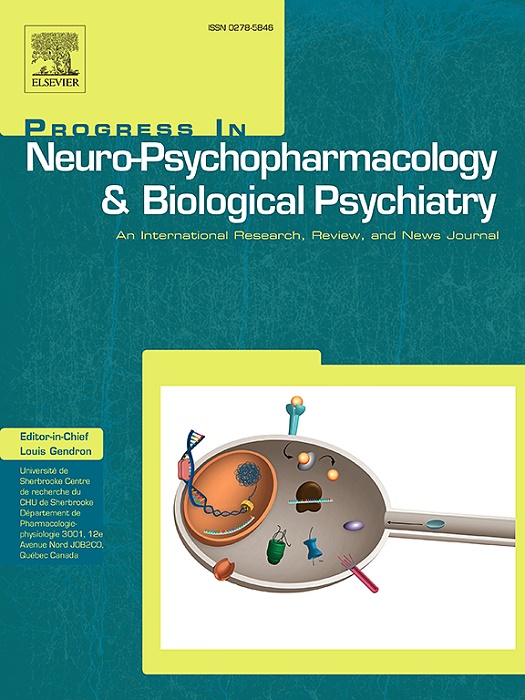Captopril prevents depressive-like behavior in an animal model of depression by enhancing hippocampal neurogenesis via activation of the ACE2/Ang (1–7)/Mas receptor/AMPK/BDNF pathway
IF 5.3
2区 医学
Q1 CLINICAL NEUROLOGY
Progress in Neuro-Psychopharmacology & Biological Psychiatry
Pub Date : 2024-11-17
DOI:10.1016/j.pnpbp.2024.111198
引用次数: 0
Abstract
The brain's Renin-Angiotensin System plays an important role in the modulation of mental state. Previously we demonstrated that activated angiotensin (Ang) converting enzyme (ACE) 2, which converts Ang II into Ang (1–7), or the intracerebroventricular administration of Ang (1–7) produced an antidepressant-like effect in mice via Mas receptors (MasR). Since the ACE inhibitor Captopril (Cap) increases Ang (1–7) in the brain, it remains unknown whether Cap affects the depressive-like behavior of olfactory bulbectomized (OBX) mice, an animal model of depression. We tested the effect of Cap on the depressive-like behavior of these mice in the tail-suspension test, quantified ACE2, p-AMP activated protein kinase (AMPK), and brain-derived neurotrophic factor (BDNF) using western blots, and examined the changes in Ang (1–7) level, neurogenesis, and in the expression of ACE2 and MasR on various cell types in the hippocampus using immunohistochemistry. While OBX mice exhibited a depressive-like behavior in the tail-suspension test, as well as a reduction in ACE2, Ang (1–7), p-AMPK, BDNF, and hippocampal neurogenesis, these changes were prevented by Cap administration. The intracerebroventricular administration of Ang (1–7) improved the OBX-induced depressive-like behavior. Except for the changes in ACE2 and Ang (1–7), the effects of Cap were inhibited by the coadministration of A779 (MasR inhibitor) or Compound-C (AMPK inhibitor). ACE2 localized to all cell types, while MasR localized to microglia and neurons. Our results suggest that Cap may act on ACE2-positive cells in the hippocampus to increase ACE2 expression level, thereby enhancing signaling in the ACE2/Ang (1–7)/MasR/AMPK/BDNF pathway and producing antidepressant-like effects.
卡托普利通过激活 ACE2/Ang (1-7)/Mas 受体/AMPK/BDNF通路增强海马神经发生,从而预防抑郁症动物模型中的抑郁样行为。
大脑的肾素-血管紧张素系统在调节精神状态方面发挥着重要作用。此前我们曾证实,激活血管紧张素(Ang)转换酶(ACE)2(可将 Ang II 转换为 Ang (1-7))或脑室内注射 Ang (1-7)可通过 Mas 受体(MasR)对小鼠产生类似抗抑郁的作用。由于 ACE 抑制剂卡托普利(Captopril,Cap)会增加大脑中的 Ang (1-7),Cap 是否会影响嗅球切除(OBX)小鼠(一种抑郁症动物模型)的抑郁样行为仍是未知数。我们在尾悬吊试验中测试了 Cap 对这些小鼠抑郁样行为的影响,使用 Western 印迹对 ACE2、p-AMPK 活化蛋白激酶 (AMPK) 和脑源性神经营养因子 (BDNF) 进行了定量分析,并使用免疫组化方法检测了 Ang (1-7) 水平、神经发生以及 ACE2 和 MasR 在海马各种细胞类型上的表达变化。OBX小鼠在尾悬吊试验中表现出类似抑郁的行为,ACE2、Ang (1-7)、p-AMPK、BDNF和海马神经发生也有所减少,但这些变化都被Cap给药所阻止。脑室内注射 Ang (1-7) 可改善 OBX 诱导的抑郁样行为。除了 ACE2 和 Ang (1-7) 的变化外,Cap 的作用在联合给药 A779(MasR 抑制剂)或化合物-C(AMPK 抑制剂)后被抑制。ACE2 定位于所有细胞类型,而 MasR 定位于小胶质细胞和神经元。我们的研究结果表明,Cap 可能会作用于海马中 ACE2 阳性的细胞,提高 ACE2 的表达水平,从而增强 ACE2/Ang (1-7)/MasR/AMPK/BDNF 通路的信号转导,产生类似抗抑郁的作用。
本文章由计算机程序翻译,如有差异,请以英文原文为准。
求助全文
约1分钟内获得全文
求助全文
来源期刊
CiteScore
12.00
自引率
1.80%
发文量
153
审稿时长
56 days
期刊介绍:
Progress in Neuro-Psychopharmacology & Biological Psychiatry is an international and multidisciplinary journal which aims to ensure the rapid publication of authoritative reviews and research papers dealing with experimental and clinical aspects of neuro-psychopharmacology and biological psychiatry. Issues of the journal are regularly devoted wholly in or in part to a topical subject.
Progress in Neuro-Psychopharmacology & Biological Psychiatry does not publish work on the actions of biological extracts unless the pharmacological active molecular substrate and/or specific receptor binding properties of the extract compounds are elucidated.

 求助内容:
求助内容: 应助结果提醒方式:
应助结果提醒方式:


